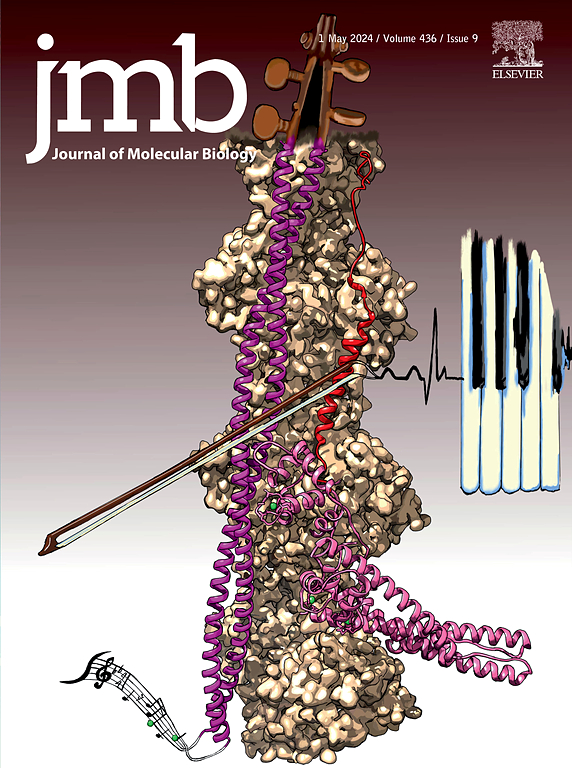The Citrullinating Enzyme PADI4 Binds to Lipids: Identification of New Target Interactions for Cancer Therapy
IF 4.5
2区 生物学
Q1 BIOCHEMISTRY & MOLECULAR BIOLOGY
引用次数: 0
Abstract
Cancer cells need to implement and maintain molecular mechanisms relying on an energy trade-off between resistance and key functions to survive. Among them, changes in lipid metabolism are crucial. Phosphatidylserine (PS), phosphatidylcholine (PC) and phosphatidic acid (PA) are some of the lipids forming cell membranes and having key functions in lipid metabolism. PADI4 is an enzyme implicated in the conversion of arginine to citrulline (citrullination), that has been related with the development of several types of cancers. In this work, we report the lipid binding properties of PADI4. Such binding was assayed in vitro against zwitterionic (PC) and anionic (PA and PS) lipids, and it was monitored by several biophysical techniques. Furthermore, results in silico showed that the binding of PADI4 with PA, PC and PS occurred at the active site of the enzyme. This binding was confirmed in cellulo by using PS as the target lipid, employing immunofluorescence (IF) and proximity ligation assay (PLA) in different cancer cell lines. The use in cellulo of a specific enzymatic inhibitor of PADI4, GSK484, abolished the binding between PADI4 and PS in cancer cells, further indicating that their interaction occurred at the protein active site. Altogether, this work shows that PADI4 was capable of binding to lipids, and opens the venue to study the role that it could be playing in deimination processes and cancer development. Moreover, this study lays the foundation for developing novel cancer therapies from new perspectives, based on the interaction of lipids with citrullinating enzymes.

瓜氨酸化酶PADI4与脂质结合:癌症治疗新靶标相互作用的鉴定。
癌细胞需要实施和维持依赖于抗性和关键功能之间的能量权衡的分子机制来生存。其中,脂质代谢的变化至关重要。磷脂酰丝氨酸(PS)、磷脂酰胆碱(PC)和磷脂酸(PA)是形成细胞膜的脂质,在脂质代谢中起关键作用。PADI4是一种与精氨酸转化为瓜氨酸(瓜氨酸化)有关的酶,它与几种癌症的发展有关。在这项工作中,我们报道了PADI4的脂质结合特性。体外测定了这种结合对两性离子(PC)和阴离子(PA和PS)脂质的影响,并通过几种生物物理技术对其进行了监测。此外,结果表明,PADI4与PA、PC和PS的结合发生在酶的活性位点。利用免疫荧光(IF)和近端结扎实验(PLA)在不同的癌细胞系中证实了这种结合。在纤维素中使用PADI4的特异性酶抑制剂GSK484,消除了癌细胞中PADI4和PS之间的结合,进一步表明它们的相互作用发生在蛋白质活性位点。总之,这项工作表明PADI4能够与脂质结合,并为研究它在消除过程和癌症发展中可能发挥的作用开辟了道路。此外,本研究为从新的角度开发基于脂质与瓜氨酸化酶相互作用的新型癌症治疗奠定了基础。
本文章由计算机程序翻译,如有差异,请以英文原文为准。
求助全文
约1分钟内获得全文
求助全文
来源期刊

Journal of Molecular Biology
生物-生化与分子生物学
CiteScore
11.30
自引率
1.80%
发文量
412
审稿时长
28 days
期刊介绍:
Journal of Molecular Biology (JMB) provides high quality, comprehensive and broad coverage in all areas of molecular biology. The journal publishes original scientific research papers that provide mechanistic and functional insights and report a significant advance to the field. The journal encourages the submission of multidisciplinary studies that use complementary experimental and computational approaches to address challenging biological questions.
Research areas include but are not limited to: Biomolecular interactions, signaling networks, systems biology; Cell cycle, cell growth, cell differentiation; Cell death, autophagy; Cell signaling and regulation; Chemical biology; Computational biology, in combination with experimental studies; DNA replication, repair, and recombination; Development, regenerative biology, mechanistic and functional studies of stem cells; Epigenetics, chromatin structure and function; Gene expression; Membrane processes, cell surface proteins and cell-cell interactions; Methodological advances, both experimental and theoretical, including databases; Microbiology, virology, and interactions with the host or environment; Microbiota mechanistic and functional studies; Nuclear organization; Post-translational modifications, proteomics; Processing and function of biologically important macromolecules and complexes; Molecular basis of disease; RNA processing, structure and functions of non-coding RNAs, transcription; Sorting, spatiotemporal organization, trafficking; Structural biology; Synthetic biology; Translation, protein folding, chaperones, protein degradation and quality control.
 求助内容:
求助内容: 应助结果提醒方式:
应助结果提醒方式:


